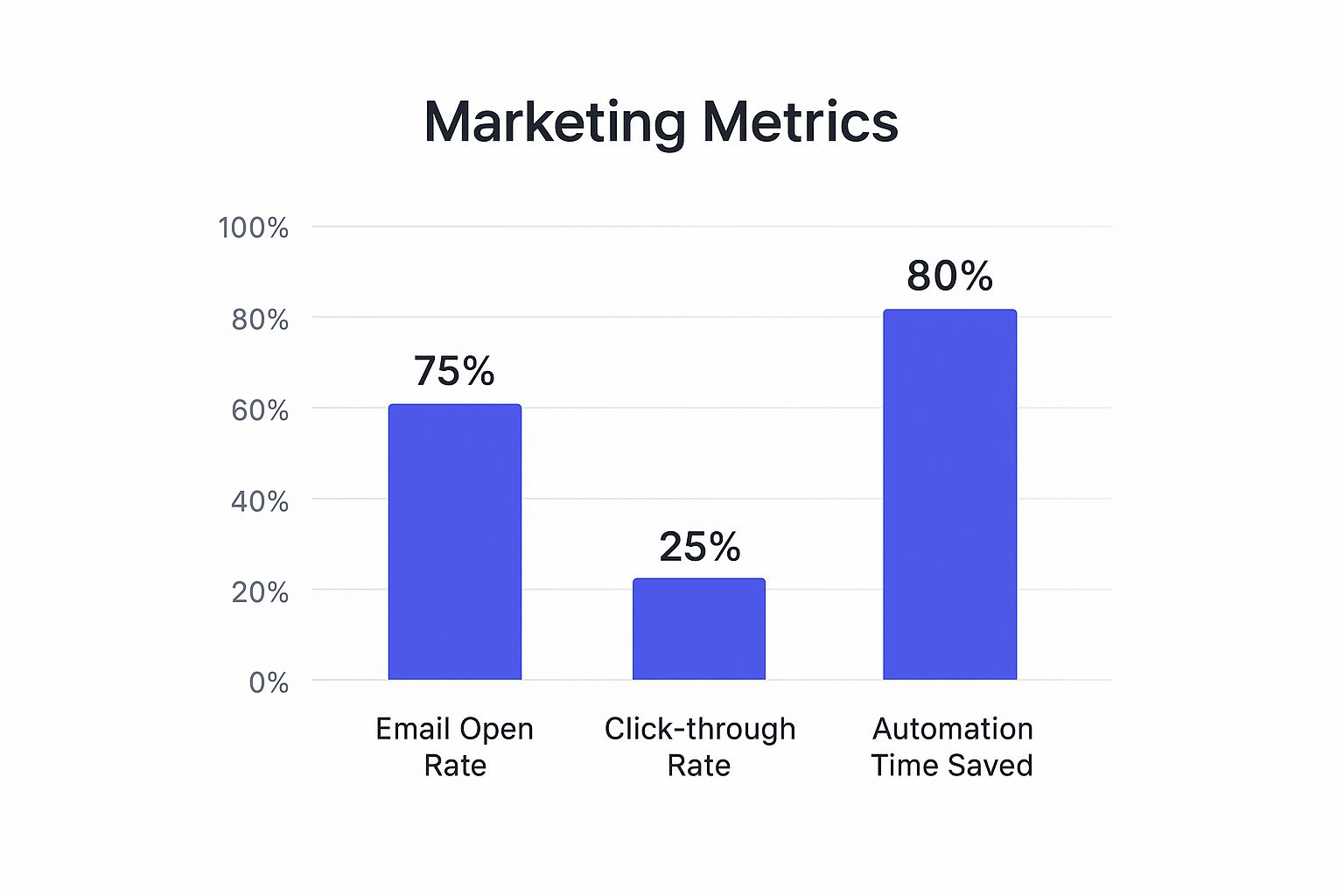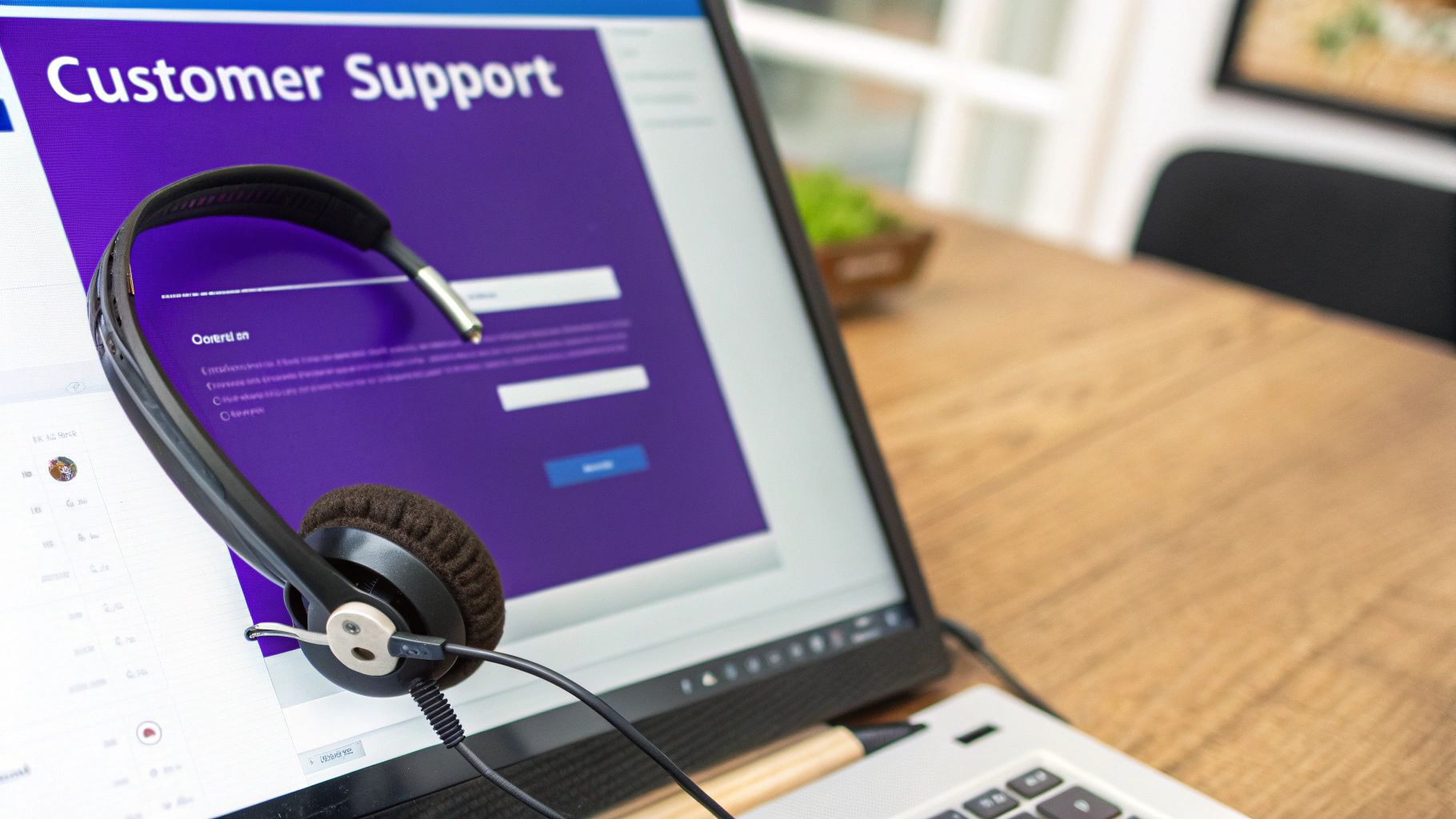Navigating Today's Digital Product Landscape
The digital product world is a vibrant and ever-shifting space. Understanding this landscape is key to successfully delivering your digital offerings. This means keeping up with market trends, consumer behavior, and the winning strategies of successful digital entrepreneurs. This knowledge forms the bedrock of a successful digital product delivery strategy.
Understanding the Evolving Market
The rise of digital products has dramatically reshaped how businesses operate and interact with their customers. This shift is fueled by a significant increase in digital transactions. In fact, the volume of digital product transactions has exploded by nearly 70% in the past two years. This growth highlights the enormous potential of digital products, which already represent a considerable chunk of consumer spending.
In 2020 alone, more than 2 billion consumers purchased digital products, showcasing the global embrace of digital goods. As digital products continue to gain popularity, businesses are concentrating on improving delivery methods to create better customer experiences, ensuring content is delivered efficiently and securely. For a deeper dive into these statistics, check out this resource: Learn more about digital product statistics. This rapid expansion demands a sharp understanding of efficient and effective digital product delivery.
Meeting Consumer Expectations
Today's consumers have high expectations for digital products. They want instant access, smooth delivery, and a user-friendly experience. Think about how quickly you expect to access an ebook or online course after purchase. This instant gratification is a hallmark of the digital product market.
Consumers also expect personalized experiences and relevant content delivered across multiple channels. Businesses must adapt their delivery strategies to meet these evolving demands.
Learning From Successful Creators
Studying successful digital entrepreneurs offers valuable lessons in effective delivery strategies. Many top creators focus on building strong communities around their products. This boosts engagement and encourages repeat purchases.
They also prioritize excellent customer support and regularly update their products based on customer feedback. This shows dedication to customer satisfaction and cultivates long-term loyalty. Understanding digital product delivery isn't just about the technical side; it's about creating a positive and engaging customer experience.
Positioning for Success in a Crowded Marketplace
The growth of the digital product market brings increased competition. Standing out requires a strategic approach to product positioning and delivery. This includes building a compelling brand story, showcasing your product's unique value, and selecting the right delivery methods to connect with your target audience.
For instance, a Shopify store owner using Tevello can integrate courses and communities directly into their shop, offering a seamless and integrated experience. This provides a competitive edge by delivering a more comprehensive and engaging experience than standalone platforms. By understanding the current digital landscape and implementing effective delivery strategies, you can position your digital products for success in this booming market.

Building Your Digital Delivery Infrastructure
A seamless digital product delivery experience relies on a robust technical foundation. This involves carefully choosing the right tools and services, from hosting and payment gateways to security measures. It's about looking beyond marketing hype and focusing on solutions that truly perform. Let's explore the essential components of a reliable delivery system, drawing on insights from technical directors and platform architects.
Choosing The Right Hosting Solution
Your hosting provider is the cornerstone of your digital product delivery. Select a solution that can handle traffic spikes and scale alongside your business. Reliability is key; downtime equals lost revenue and frustrated customers. For instance, if you're selling online courses, a platform like Tevello integrated with your Shopify store ensures a smooth experience without redirecting customers. This integration minimizes potential technical debt, allowing for easier scaling.
Secure and Efficient Payment Processing
The payment process should be both secure and user-friendly. Customers expect various payment options, from credit cards to digital wallets. A cumbersome checkout can lead to abandoned carts and lost sales. Robust security, including secure payment gateways and fraud prevention, is also vital to protect both you and your customers.
Balancing Security and User Experience
Security is crucial, but it shouldn't compromise the user experience. Think about annoying CAPTCHAs that block legitimate users. The goal is to find a balance between protecting your digital assets and providing easy access for paying customers. This might involve tiered security based on product value or watermarking to deter unauthorized sharing without hindering legitimate use.

The infographic above illustrates key email marketing automation data, showcasing open rates, click-through rates, and time saved. Email automation significantly improves efficiency with an 80% time savings, while maintaining 75% open rates and 25% click-through rates. These metrics demonstrate the effectiveness of email automation for digital product delivery and customer engagement.
Evaluating Technical Partners and Integrations
Choosing the right technical partners is as crucial as selecting the right hosting platform. Consider their track record, support, and how easily they integrate with your existing systems. Thorough research and testing can prevent costly integration problems. This minimizes technical debt and allows for smooth, scalable growth. Integrating your platform with a service like ThriveCart can enhance checkout efficiency and improve the customer experience.
To help you navigate the various platforms available, the table below provides a comprehensive comparison:
Digital Product Delivery Platforms Comparison: A comprehensive comparison of popular platforms for delivering digital products, including features, pricing, and best use cases.
| Platform | Best For | Key Features | Price Range | Customer Support | Scalability |
|---|---|---|---|---|---|
| Tevello | Shopify integration, course delivery | Embedded courses, community features, integrated checkout | $19.99/month | Email, chat, documentation | Scalable with Shopify |
| ThriveCart | Sales funnels, checkout optimization | Flexible checkout options, upsells, downsells | Varies based on plan | Email, chat, documentation | Highly scalable |
| Podia | Course creators, membership sites | All-in-one platform for courses, memberships, digital downloads | Varies based on plan | Email, chat, documentation | Scalable |
| Thinkific | Course creators, online schools | Course creation tools, student management, community features | Varies based on plan | Email, chat, documentation | Scalable |
| Teachable | Course creators, online schools | Course creation tools, student management, marketing features | Varies based on plan | Email, chat, documentation | Scalable |
This table summarizes key features and considerations when choosing a platform for your digital products. Remember to research and compare options based on your specific needs and business goals.
Building your digital delivery infrastructure is an ongoing process. It's about choosing the right tools, implementing strong security, and continually refining your system based on evolving customer needs and technology. This establishes the foundation for a successful and scalable digital product business. By prioritizing a robust and secure infrastructure, you can focus on creating and delivering high-quality digital products.
Crafting a Frictionless Purchase Experience
The journey from a customer's purchase decision to accessing your digital product is critical. Optimizing this experience is key to success. This means understanding online purchasing psychology and using conversion data to create a seamless and satisfying transaction. Leading digital creators continuously refine this process to minimize obstacles and maximize conversions.
Checkout Elements: Building Trust vs. Triggering Abandonment
Some checkout elements build trust, while others can cause cart abandonment. Clear product descriptions, secure payment gateways, and transparent pricing inspire confidence. Conversely, unexpected fees, complicated checkout processes, and unclear return policies can erode trust and decrease sales.
Displaying trust badges from recognized security companies like McAfee can significantly boost conversions. Offering multiple payment options caters to diverse customer preferences and further smooths the purchase process.
Payment Options: Meeting Customer Expectations
Today's consumers expect a range of payment options. Limited choices can deter potential buyers. Supporting major credit cards, digital wallets like PayPal and Apple Pay, and even cryptocurrency when relevant, demonstrates an understanding of modern consumer needs. This flexibility broadens your audience and reduces purchase barriers.
A streamlined checkout process, optimized for desktop and mobile, is essential for capturing today's on-the-go consumer. This directly impacts conversion rates and overall customer satisfaction.
Post-Purchase Communication: Setting the Stage for Successful Delivery
Effective post-purchase communication is essential for a positive delivery experience. A confirmation email with clear product access instructions sets the right tone. Follow-up emails with additional resources or support further enhance the customer journey.
This proactive approach builds trust and reduces support requests. Clear, timely communication manages customer expectations and contributes to a positive overall impression. To minimize friction, consider using abandoned cart recovery text messages to optimize your checkout experience.
Optimizing the Purchase Flow: Small Changes, Big Impact
Small optimizations in the purchase flow can significantly improve customer satisfaction and reduce support inquiries. A progress bar during checkout can reduce anxiety and provide a sense of control. Guest checkout options streamline the process for first-time buyers.
Analyzing user behavior data can pinpoint pain points in the purchase journey. This data-driven approach enables targeted improvements that directly impact conversion rates and customer satisfaction. These seemingly minor adjustments can substantially improve the overall customer experience. By implementing these strategies, you can build customer trust and create a seamless and satisfying purchase experience. The global e-commerce market is booming. By 2025, global eCommerce sales are expected to reach $7.5 trillion, up from $5.7 trillion in 2023. Find more detailed statistics here. This growth is driven by increased internet and mobile commerce adoption. The increasing popularity of digital products emphasizes the importance of a frictionless purchase experience.
Matching Delivery Methods to Your Digital Products

Choosing the right delivery method for your digital product is crucial. It's as important as the product itself. A well-executed delivery strategy can significantly boost customer satisfaction and drive sales. Conversely, a poor delivery method can lead to frustrated customers and lost revenue. This emphasizes the need to align your delivery strategy with your product format, content complexity, and, above all, customer expectations.
Moving Beyond Simple Download Links
Many leading course creators are moving away from simple download links. They are opting for more sophisticated delivery approaches. This shift is driven by the increasing expectation for a streamlined, integrated experience. Imagine you've purchased a multi-module course. Would you prefer a single download link, or access through a dedicated learning platform? A platform with features like progress tracking and community forums offers a more engaging and interactive learning environment. Platforms like Tevello enable Shopify store owners to embed courses directly into their shops. This provides a seamless user experience for their customers.
For software developers, access provisioning is evolving. Many are shifting from static licenses to subscription models. These models offer tiered access based on individual user needs. This approach provides flexibility for customers and generates recurring revenue for the business. However, it requires a robust delivery infrastructure to manage subscriptions, updates, and user access.
Content Consumption Patterns and Delivery Timing
Understanding how people consume content is key to effective delivery timing. Dripping content over time, rather than releasing everything at once, can be more effective, especially for complex topics. This allows learners to absorb information at their own pace. This approach can improve knowledge retention and overall engagement. Consider incorporating elements like quizzes and progress tracking to further enhance the learning experience.
Access Models: Pros, Cons, and Decision Frameworks
Different access models offer distinct advantages and disadvantages. Unlimited access can be appealing to customers but increases the risk of unauthorized sharing. Time-limited access creates a sense of urgency. However, this model may not be suitable for all learning styles. Subscription-based access generates recurring revenue but demands ongoing content updates and robust customer management. The ideal model depends on your specific product and target audience. For more insights on launching digital products, check out this helpful resource: How to master your digital product launch. This guide offers valuable advice on optimizing your launch strategy for various access models.
To streamline the transaction process and minimize friction, consider leveraging abandoned cart recovery text messages. Learn how to optimize your checkout experience.
Testing and Refining Your Delivery Approach
Testing different delivery methods is essential. Gather customer feedback through surveys and analyze data to determine what resonates most with your audience. Continuously refining your systems based on this feedback is vital for long-term success. This iterative process ensures your delivery method stays aligned with evolving customer needs and technological advancements.
To help illustrate optimal delivery methods for various digital products, the following table provides a detailed breakdown.
Digital Product Types and Recommended Delivery Methods: A detailed breakdown of optimal delivery approaches for different categories of digital products
| Product Type | Recommended Delivery Method | Pros | Cons | Security Considerations | Examples |
|---|---|---|---|---|---|
| Online Courses | Dedicated Learning Platform | Structured learning, progress tracking, community features | Requires platform management | Access controls, data encryption | Tevello |
| Software | Subscription Model | Recurring revenue, flexible access | Requires robust infrastructure | Secure authentication, regular updates | Adobe Creative Cloud |
| Ebooks, Guides | Direct Download or Online Reader | Instant access, simple delivery | Prone to unauthorized sharing | DRM, watermarking | Amazon Kindle |
| Templates, Tools | Membership Site | Exclusive access, valuable resources | Requires ongoing content creation | Access restrictions, content protection | Canva Pro |
This table summarizes common digital product types and their recommended delivery methods. Each method presents unique benefits and challenges. This underscores the importance of choosing a delivery approach tailored to your specific product and target audience. By carefully evaluating these factors and implementing a strategic approach, you can transform your delivery method. It can become a competitive advantage, not just a functional necessity.
Automating Your Way to Scalable Delivery
As your digital product business grows, manual delivery can become a major roadblock. This is where automation comes in. Successful digital creators understand the value of automation systems for consistent delivery, freeing them to focus on the bigger picture.
This allows creators to concentrate on what truly matters: creating high-quality content, engaging their audience, and ultimately, expanding their business.
Building Automated Delivery Workflows
Imagine this: a customer purchases your online course. Instead of manually sending them login details, an automated system instantly grants access upon payment. This seamless automation streamlines the entire customer journey.
These automated workflows can handle many tasks, from delivering bonus materials to managing subscriptions, all without constant oversight. This not only saves you valuable time but also ensures a reliable and consistent customer experience.
This seamless delivery boosts customer satisfaction and strengthens your brand. It also allows you to focus on content creation, knowing your delivery system is running smoothly in the background. Automation reduces the risk of human error, ensuring accurate and on-time delivery every single time.
Triggered Sequences for Enhanced Customer Experience
Automation goes beyond just product delivery. Think about a series of welcome emails sent automatically after purchase. These emails can onboard new customers, offer valuable resources, and nurture the budding customer relationship.
For example, a welcome email immediately after purchase confirms the order and provides access instructions. A follow-up email a few days later might suggest supplementary resources or invite the customer to a community forum. These automated touchpoints personalize the customer experience.
This personalization increases customer satisfaction and builds a stronger brand connection. You can find additional tips on improving the customer experience here: How to master creating engaging online courses.
Empowering Customers With Self-Service Options
Self-service resources, like FAQs and knowledge bases, streamline the delivery process even further. These resources empower customers to find answers independently, reducing support tickets and freeing up your team.
This not only improves customer satisfaction but also boosts internal efficiency. By providing readily available information, you reduce the need for direct support interaction, letting your team focus on more strategic tasks.
Providing robust self-service shows your commitment to customer empowerment, building trust and long-term loyalty.
Integrating Automation Tools With Delivery Platforms
Many automation tools integrate smoothly with popular delivery platforms. This allows you to connect your platform with email marketing services, CRM systems, and other essential business tools.
This integration creates a unified system, automating tasks like onboarding, product access, and post-purchase communication. A well-integrated system is crucial for a seamless and efficient automated delivery process.
Automating these tasks ensures a consistent and personalized experience while also streamlining your operations. This reduces manual work, minimizes errors, and allows for greater scalability as your business expands. Strategic automation builds a robust and scalable delivery system that empowers your business to flourish.
Protecting Your Digital Assets Without Frustrating Customers

Balancing security and a smooth customer experience is crucial for digital creators. How can you protect your intellectual property while ensuring paying customers easily access their purchases? This section explores strategies that prioritize both security and customer satisfaction, drawing on insights from digital security experts and successful creators.
Tiered Security Approaches Based on Product Value
A tiered approach to security recognizes that not all digital products require the same level of protection. A low-cost ebook might only need basic download protection. A high-value online course, on the other hand, benefits from more robust measures. These could include watermarking or access controls. This strategy ensures appropriate protection without unnecessary complexity for lower-risk items, allowing you to scale security as your product offerings grow.
Watermarking: Deterring Sharing While Respecting Users
Watermarking acts as a strong deterrent against unauthorized sharing. By subtly embedding customer-specific information into your product, you can trace leaks without impacting legitimate users. For instance, embedding a customer's email within a PDF helps identify the original purchaser if shared illegally. However, a balance is essential. Overly intrusive watermarks can frustrate legitimate users, potentially harming your brand.
Access Control Methods for Intellectual Property Protection
Controlling access is fundamental to protecting your digital assets. This involves implementing secure login systems and potentially limiting downloads. Tevello, integrated with your Shopify store, offers robust built-in access controls. It manages user permissions and protects your content without creating extra steps for customers. Tevello also allows private communities within your Shopify store, further enhancing control.
Addressing Common Scenarios: Account Sharing, Download Limits, and License Verification
Common challenges include account sharing, exceeding download limits, and license verification. These require clear policies and communication. Setting clear expectations about account usage upfront prevents later misunderstandings. For example, explicitly stating your account sharing policy in your terms of service can deter this behavior.
Implementing download limits adds another layer of protection without inconveniencing legitimate users. Digital products benefit from instant accessibility upon purchase. This seamless delivery contrasts with physical goods, where 74% of online shoppers expect delivery within two days. Learn more about e-commerce delivery statistics. This instant gratification enhances customer experience and builds positive brand perception.
To scale your delivery effectively, automation is key. Automatic social media posting can streamline your marketing, reaching a wider audience and promoting your products more efficiently. Ultimately, protecting your digital assets is about finding the right balance between strong security and a positive customer experience.
Key Implementation Strategies for Digital Delivery Success
Building a successful digital product delivery system requires a well-defined strategy. This section offers a practical guide for creating effective systems tailored to your unique digital products, from initial setup to ongoing improvements.
Building Your Action Plan
First, clearly define your delivery goals. What are you hoping to achieve with your system? Is your focus on speed, robust security, or perhaps a more personalized customer experience? After outlining your objectives, create a checklist of necessary steps. This should encompass everything from selecting the right platform to setting up automated workflows. Prioritize tasks based on their potential impact and feasibility. A structured approach like this will keep you focused and on track. Looking for the right platform? Consider checking out these Best Platforms for Selling Digital Products.
Sequencing Delivery Improvements for Maximum Impact
Successful creators often prioritize their delivery improvements strategically. For example, they might optimize the checkout process before tackling more complex automation. This allows for quick wins in high-impact areas, generating momentum early on. Focusing on areas with the greatest potential for improvement first maximizes your return on investment.
Metrics That Matter: Measuring Real Delivery Success
Avoid getting bogged down in vanity metrics. Downloads alone don't provide a complete picture. Instead, concentrate on metrics that truly reflect delivery success, such as customer satisfaction, conversion rates, and refund requests. These metrics offer more valuable insights into how well your system is performing. Tracking these key performance indicators helps pinpoint areas for improvement and measure the impact of changes you implement. A low refund rate, for instance, can suggest a smooth delivery process and satisfied customers.
Continuous Refinement: Adapting to Evolving Expectations
The online world is always evolving. Regularly refine your delivery systems based on customer feedback, new technologies, and market trends. Actively seek customer feedback through surveys and analyze user behavior data to uncover any pain points and potential areas for improvement. This proactive approach helps ensure your system remains effective and competitive. For example, integrating new payment methods as they emerge can improve the customer experience and potentially boost conversions.
Resource Allocation and ROI on Delivery Improvements
Allocate resources effectively to maximize your return on investment for delivery improvements. Consider factors like the cost of new tools, the time required for implementation, and the potential impact on revenue. Prioritize investments that offer the best balance of growth and efficiency. Automating key processes, for example, can save time and money over the long term, freeing up resources for other areas of your business.
By following these strategies, you can build a digital product delivery system that not only operates efficiently but also becomes a key competitive advantage, boosting customer satisfaction and driving business growth.
Ready to streamline your digital product delivery?
Whether you're launching your first online course or scaling a digital product business, Tevello makes it simple to sell, manage, and deliver content directly through Shopify.
Try Tevello for free today and create a seamless experience your customers will love.

